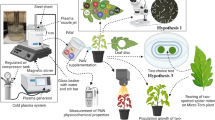Abstract
The objective of this study was to determine if the two surfaces of a leaf had different, or the same, water potentials. Maize (Zea mays L. cv. Cargill 805) was the test plant. During an 11 day period, the water potentials of the upper and lower surfaces of the maize leaves were measured daily with anin situ thermocouple psychrometer under growth-room conditions. Plants were grown in pots with a well-watered, commercial greenhouse soil. Stomatal resistance also was measured. The water potential of the upper surface was less negative (more wet) than that of the lower surface. The overall average of the water potential of the upper and lower surfaces was −1.48 and −2.07 MPa, respectively. The stomatal resistance of the upper surface was greater than that of the lower surface. The average stomatal resistance during the experiment was 780 and 600 s m−1 for the upper and lower surfaces, respectively. Since the upper and lower surfaces were not at the same water potential, the results indicated that the parallel-resistance equation, used to combine resistances on the two surfaces of a leaf, was not strictly valid when applied to the maize leaves, as the law assumes equal potentials on the two surfaces.
Similar content being viewed by others
References
Campbell, G. S., Zollinger, W. D., Taylor, S. A.: Sample changer for thermocouple psychrometers: construction and some applications. - Agron. J.58: 315–318, 1966.
Cooke, J. R., De Baerdemaeker, J. G., Rand, R. H., Mang, H. A.: A finite element shell analysis of guard cell deformations. - Trans. Amer. Soc. Agr. Eng.19: 1107–1121, 1976.
Esau, K.: Plant Anatomy. Second edition. - John Wiley and Sons, New York 1965.
Gardner, W. R.: Internal water status and plant response in relation to the external water régime. - In:Slatyer, R. O. (ed.): Plant Response to Climatic Factors. Pp. 221–225. United Nations Educational, Scientific, and Cultural Organization, Paris 1973.
Hashimoto, Y., Ino, T., Kramer, P. J., Naylor, A. W., Strain, B. R.: Dynamic analysis of water stress of sunflower leaves by means of a thermal image processing system. - Plant Physiol.76: 266–269, 1984.
Hesketh, J. D., Moss, D. N.: Variation in the response of photosynthesis to light. - Crop Sci.3: 107–110, 1963.
Hoffman, G. J., Splinter, W. E.: Water potential measurements of an intact plant-soil system. - Agron. J.60: 408–413, 1968.
Koller, D.: Solar tracking (phototropism) in leaves ofLavatera cretica andMalva parviflora. - In: Annual Report of the Director, Department of Plant Biology. Pp. 72–75. Carnegie Institution of Washington Year Book 80, Stanford, California 1981.
Lang, A. R. G.: Osmotic coefficients and water potentials of sodium chloride solutions from 0 to 40 °C. - Aust. J. Chem.20: 2017–2023, 1967.
Mansfield, T. A.: Movements of stomata. - Sci. Prog.68: 519–542, 1983.
Nobel, P. S.: Introduction to Biophysical Plant Physiology. - W. H. Freeman and Company, San Francisco 1974.
Raschke, K.: Stomatal responses to pressure changes and interruptions in the water supply of detached leaves ofZea mays L.- Plant Physiol.45: 415–423, 1970.
Sheriff, D. W., Meidner, H.: Water pathways in leaves ofHedera helix L. andTradescantia virginiana L.- J. exp. Bot.25: 1147–1156, 1974.
Slavík, B.: Gradients of osmotic pressure of cell sap in the area of one leaf blade. - Biol. Plant.1: 39–47, 1959.
Slavík, B.: The distribution pattern of transpiration rate, water saturation deficit, stomata number and size, photosynthetic and respiration rate in the area of the tobacco leaf blade. - Biol. Plant.5: 143–153, 1963a.
Slavík, B.: On the problem of the relationship between hydration of leaf tissue and intensity of photosynthesis and respiration. - In:Whitehead, F. H., Rutter, A. J. (ed.): The Water Relations of Plants. Pp. 225–234. Blackwell Scientific Publications, Oxford 1963b.
Steel, R.G.D., Torrie, J. H.: Principles and Procedures of Statistics. - McGraw-Hill Book Company, Inc., New York 1960.
Thimijan, R. W., Heins, R. D.: Photometric, radiometric, and quantum light units of measure: a review of procedures for interconversion. - HortScience18: 818–821, 1983.
Turner, N. C., Spurway, R. A., Schulze, E.-D.: Comparison of water potentials measured byin situ psychrometry and pressure chamber in morphologically different species. - Plant Physiol.74: 316–319, 1984.
van Bavel, C. H. M., Nakayama, F. S., Ehrler, W. L.: Measuring transpiration resistance of leaves, - Plant Physiol.40: 535–540, 1965.
Author information
Authors and Affiliations
Additional information
Contribution No. 85-186-J, Evapotranspiration Laboratory, Department of Agronomy, Kansas Agricultural Experiment Station, Manhattan, Kansas.
Rights and permissions
About this article
Cite this article
Kirkham, M.B. Water relations of the upper and lower surfaces of maize leaves. Biol Plant 28, 249–257 (1986). https://doi.org/10.1007/BF02902287
Received:
Accepted:
Issue Date:
DOI: https://doi.org/10.1007/BF02902287




